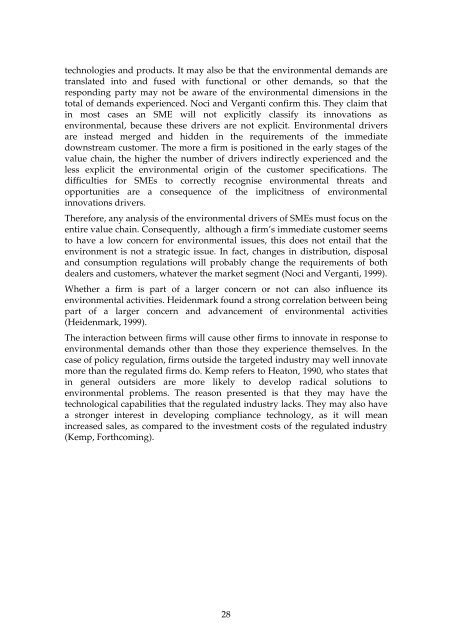Drivers of environmental innovation - Vinnova
Drivers of environmental innovation - Vinnova
Drivers of environmental innovation - Vinnova
You also want an ePaper? Increase the reach of your titles
YUMPU automatically turns print PDFs into web optimized ePapers that Google loves.
technologies and products. It may also be that the <strong>environmental</strong> demands are<br />
translated into and fused with functional or other demands, so that the<br />
responding party may not be aware <strong>of</strong> the <strong>environmental</strong> dimensions in the<br />
total <strong>of</strong> demands experienced. Noci and Verganti confirm this. They claim that<br />
in most cases an SME will not explicitly classify its <strong>innovation</strong>s as<br />
<strong>environmental</strong>, because these drivers are not explicit. Environmental drivers<br />
are instead merged and hidden in the requirements <strong>of</strong> the immediate<br />
downstream customer. The more a firm is positioned in the early stages <strong>of</strong> the<br />
value chain, the higher the number <strong>of</strong> drivers indirectly experienced and the<br />
less explicit the <strong>environmental</strong> origin <strong>of</strong> the customer specifications. The<br />
difficulties for SMEs to correctly recognise <strong>environmental</strong> threats and<br />
opportunities are a consequence <strong>of</strong> the implicitness <strong>of</strong> <strong>environmental</strong><br />
<strong>innovation</strong>s drivers.<br />
Therefore, any analysis <strong>of</strong> the <strong>environmental</strong> drivers <strong>of</strong> SMEs must focus on the<br />
entire value chain. Consequently, although a firm’s immediate customer seems<br />
to have a low concern for <strong>environmental</strong> issues, this does not entail that the<br />
environment is not a strategic issue. In fact, changes in distribution, disposal<br />
and consumption regulations will probably change the requirements <strong>of</strong> both<br />
dealers and customers, whatever the market segment (Noci and Verganti, 1999).<br />
Whether a firm is part <strong>of</strong> a larger concern or not can also influence its<br />
<strong>environmental</strong> activities. Heidenmark found a strong correlation between being<br />
part <strong>of</strong> a larger concern and advancement <strong>of</strong> <strong>environmental</strong> activities<br />
(Heidenmark, 1999).<br />
The interaction between firms will cause other firms to innovate in response to<br />
<strong>environmental</strong> demands other than those they experience themselves. In the<br />
case <strong>of</strong> policy regulation, firms outside the targeted industry may well innovate<br />
more than the regulated firms do. Kemp refers to Heaton, 1990, who states that<br />
in general outsiders are more likely to develop radical solutions to<br />
<strong>environmental</strong> problems. The reason presented is that they may have the<br />
technological capabilities that the regulated industry lacks. They may also have<br />
a stronger interest in developing compliance technology, as it will mean<br />
increased sales, as compared to the investment costs <strong>of</strong> the regulated industry<br />
(Kemp, Forthcoming).<br />
28

















